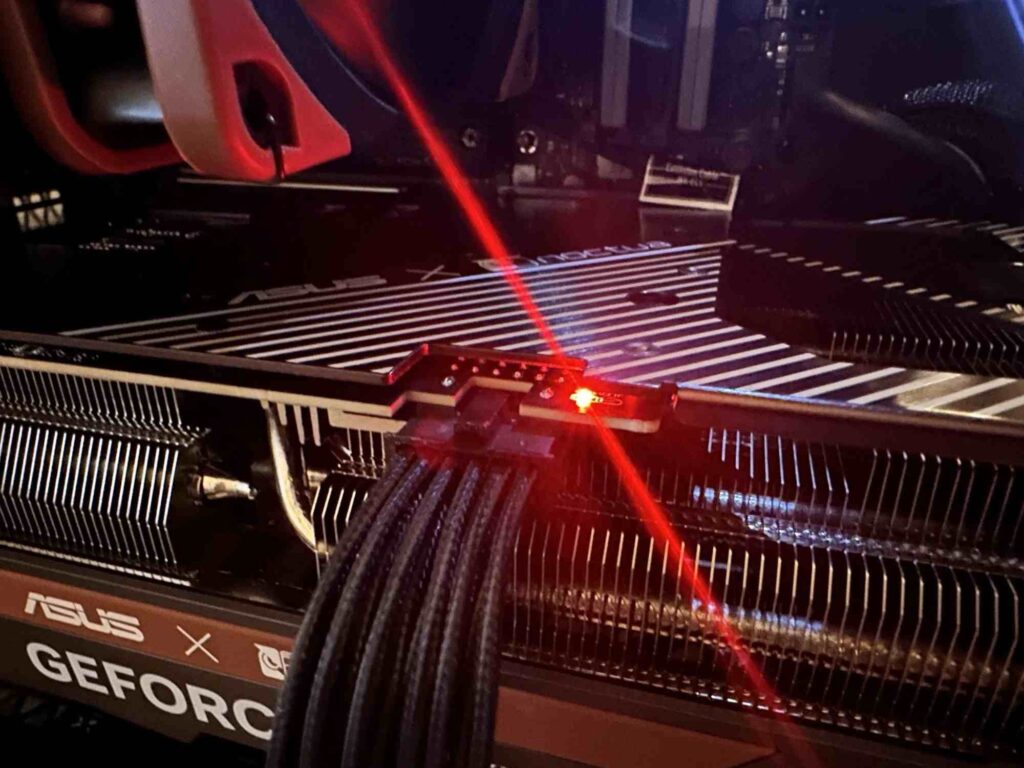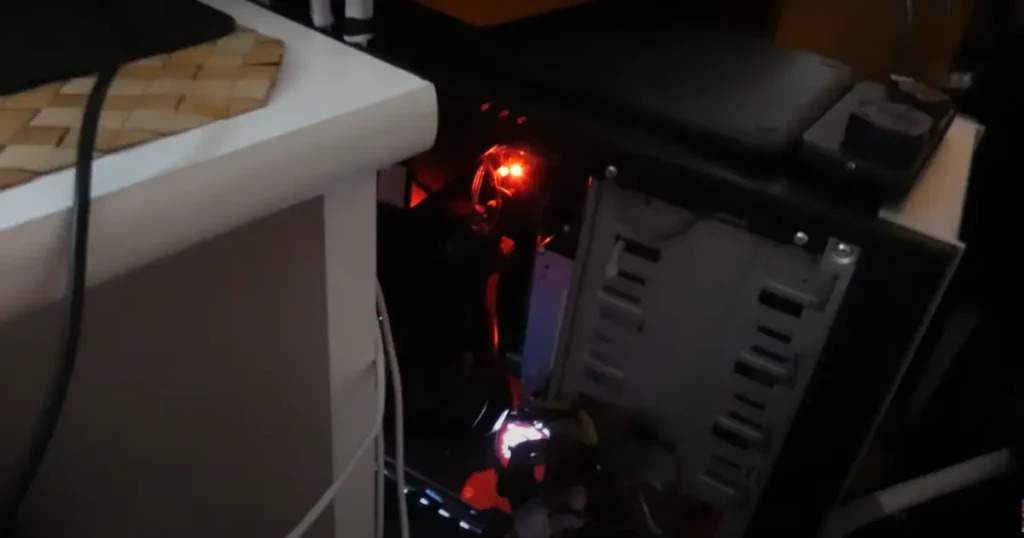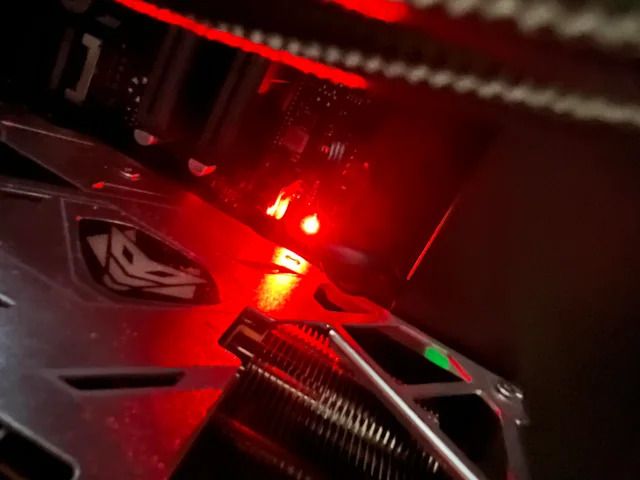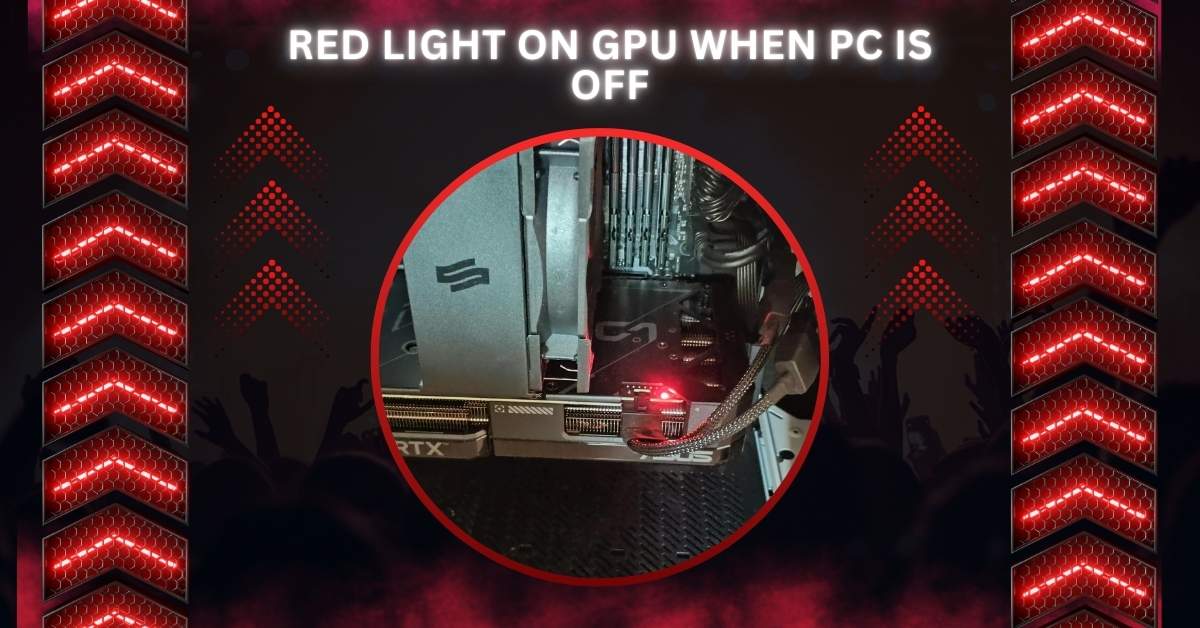A red light on your GPU usually means the card isn’t receiving steady power when the PC is off. It could be due to unsteady shutdown power, loose cables, or harmless RGB indicators. Check the PSU connections and disable standby power features if needed.
This article will explore the most common causes and practical ways to resolve the issue.
What Does the Red Light Mean?
When the PC is powered off, a red light on your GPU usually signifies either a hardware status alert or an indicator tied to system power states.
In most cases, it doesn’t necessarily mean the GPU is malfunctioning. Some manufacturers, like ASUS, configure their GPUs to display lights even in standby mode, which is considered normal.
Is the Red Light Normal?

For some GPU brands, especially ASUS, a red light is part of their standard design, indicating that the GPU is still connected to power even when the PC is off.
Other manufacturers like MSI or Gigabyte typically don’t keep LEDs active during shutdown unless configured through software.
Common Causes Behind the Red Light
1. Power Supply Issues
Residual power in the motherboard can keep the GPU LED lit, even when the PC is off. However, if the red light persists or blinks, it might point to insufficient or faulty power delivery from the power supply unit (PSU). Inadequate PSU cables or overloaded circuits may cause the GPU to signal an issue with power flow.
2. RGB and Indicator Lights
Many modern GPUs, especially high-end models from ASUS, come with customizable RGB lighting. A red light may simply be an aesthetic choice or a default setting.
Additionally, the GPU’s LED might indicate that it’s receiving standby power, maintaining minimal functionality like PCIe power settings.
3. Wake-on-LAN (WOL) Feature
Some GPUs retain the power to facilitate Wake-on-LAN (WOL) functionality, allowing the computer to wake remotely using network signals.
If this feature is enabled, the GPU may display a red indicator to signal it’s ready to respond to network activity.
4. Faulty GPU or Connection Issues
A red light can sometimes indicate that the GPU is improperly seated in the PCIe slot or that the PCIe power connectors are not properly connected. Dust or debris in the slot can also cause a weak connection, triggering the indicator light.
How to Fix the Red Light on GPU?
If the red LED concerns you or indicates a potential problem, follow these troubleshooting steps:
1. Check Power Cables and Connections
- Ensure that all power connectors are securely attached.
- Use separate PCIe cables for GPUs requiring multiple connections to prevent power delivery issues.
2. Reseat the GPU
- Shut down your PC, remove the GPU from the PCIe slot, and inspect it for dust or debris.
- Reinstall it securely to ensure proper contact with the slot.
3. Disable Wake-on-LAN (WOL) in BIOS
- If the WOL feature is unnecessary, you can turn it off via your motherboard’s BIOS to stop the LED from staying on when the system is off.
4. Adjust RGB Settings
- Check your GPU’s companion software (e.g., ASUS GPU Tweak) to customize or turn off the LED lighting. Some software options allow the LEDs to be turned off entirely when the system is off.
5. Inspect for Faulty Hardware
- If the light blinks or the GPU doesn’t perform well when powered on, there might be a hardware fault. Try testing the GPU in another system to confirm if it’s functional.
6. Replace PSU if Needed
- A weak or faulty PSU can cause inconsistent power delivery, triggering the red light even when the system is off. Consider testing with a known-good power supply if you suspect power issues.
What Should You Check If the Red Light Indicates a Problem?

- Verify Power Cables: Ensure your PSU is correctly connected to the GPU.
- Reseat the GPU: Remove and reinstall the GPU securely to eliminate connection issues.
- Inspect the PSU: Faulty power supplies can cause inconsistent power delivery and trigger the LED to stay on.
When Should You Be Concerned?
If the PC doesn’t start, crashes, or has performance issues, you should worry about the red light on your GPU.
This could mean a problem with the power cables, GPU placement, or even the PSU. If the red light stays on during use, it might signal hardware failure. Test the GPU in another PC or inspect your PSU if the issue persists.
Do All GPUs Behave This Way?
Not all GPUs show red lights when the PC is off. Some brands, like ASUS, include LEDs to signal power or connection issues.
Other brands, such as MSI or Gigabyte, turn off their lights entirely. The behavior depends on the manufacturer and the GPU’s design, so checking the manual for your specific model can help clarify the reason for the light.
Is the Red Light a Sign of GPU Failure?
A red light isn’t always a sign of GPU failure but can hint at power or connection issues. If the GPU works fine when the PC is on, the light might be part of the standard design.
However, if you notice glitches, shutdowns, or the system won’t boot, it could point to hardware failure. Reseating the GPU or testing it in another system can help.
How Is Wake-on-LAN (WOL) Related to the Red Light?
The Wake-on-LAN (WOL) feature allows a PC to turn on through network signals. In some systems, the red light on the GPU signals that WOL is active, meaning the card is ready to receive wake-up commands.
If you don’t use WOL, you can turn it off in the BIOS to stop the light from staying on when the PC is off.
What Are the Risks of Ignoring the Red Light?
Ignoring the red light on your GPU might cause more significant issues. If it signals power problems or loose connections, leaving it unchecked could lead to crashes, instability, or even permanent hardware failure.
Over time, a weak or failing power supply might damage your GPU. It’s always safer to check the cables, PSU, and GPU placement to avoid potential problems later on.
Does Every GPU Model Have an LED Indicator?
No, not all GPUs have LED indicators. Some brands like ASUS and MSI use tiny LEDs to show power status or connection issues.
Others, like Gigabyte or older models, don’t include such features. Some GPUs only have RGB lighting for aesthetics, not status indicators.
Checking the GPU manual or product page can confirm if the red light on your specific model is typical or if there is something to troubleshoot.
When Should You Replace Your GPU?
You should replace your GPU if it shows signs of failure, like constant crashes, overheating, or poor performance.
If the GPU causes boot issues or can’t handle newer games or software, it’s likely time for an upgrade. Testing it on another PC can confirm if the problem lies with the GPU.
Additionally, if the red light stays on and other fixes don’t help, the card might be faulty and need replacement.
Red Light on GPU When PC Is On

If the red light stays on while the PC is running, it could indicate a power issue, faulty cables, or improper GPU placement. To resolve the issue, check the PSU connections and ensure the GPU is seated correctly in the PCIe slot.
Red Light on GPU When PC Is Off (Windows 10)
On Windows 10 systems, the red light might appear due to active power-saving features or settings like Wake-on-LAN.
Some motherboards supply power even when the PC is off. Disabling WOL in the BIOS or changing PCIe power settings can fix this.
Red Light on GPU When PC Is Off (Gaming)
If the red light stays on after gaming, it’s likely due to power-saving features or RGB settings. Some GPUs keep lights active for aesthetic purposes. To fix this, try changing PCIe power options or turning off the GPU’s lighting in the software.
ASUS GPU Red Light When Off
ASUS GPUs often have status LEDs that can stay on to show power status. If the PC is off but the red light stays on, check your PSU and turn off the standby power settings in the BIOS. Adjusting lighting through ASUS software may help.
4070 Super Red Light When PC Is Off
Due to active RGB settings or WOL features, the 4070 Super might display a red light. Check your BIOS for standby power settings and ensure cables are correctly connected. You can turn it off through software if it’s part of the lighting.
Red Light on GPU 4070 Super
A red light on the 4070 Super could signal power delivery issues, such as a loose PSU connection. Ensure all power cables are secure. Otherwise, if the card runs fine, it may be part of the RGB system you can control in the settings.
FAQs
1. Why is the red light on my GPU when I turn off my PC?
This light could show that power-saving settings like Wake-on-LAN (WOL) are active. Your motherboard may still deliver standby power.
2. What does red light on GPU mean?
The red light often means power issues or loose connections. It might also indicate that the GPU isn’t getting enough power from the PSU.
3. Why is there a red light on my motherboard when my PC is off?
The red light on your motherboard could signal standby power. Some motherboards keep power active for features like WOL or USB charging.
4. What does light on GPU mean?
The light on your GPU can show status updates, like power delivery or connection issues. It may also be part of RGB lighting effects.
5. How to fix red light GPU?
Ensure all power cables are correctly connected. Reseat the GPU and disable WOL in the BIOS. Use GPU software to manage LED behavior.
6. How do you know if you killed your GPU?
Signs of a dead GPU include no display, frequent crashes, or the system not detecting the card. Test it on another PC to confirm.
Conclusion
In conclusion, a red light on your GPU when the PC is off can indicate several things, including power delivery issues, design features, or harmless RGB settings. It’s essential to check your connections and settings to ensure everything functions correctly. If the red light persists and affects performance, it may signal a need for further investigation or potential hardware replacement. Always prioritize proper setup to avoid any long-term issues.
